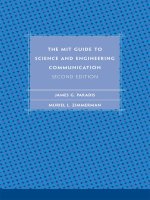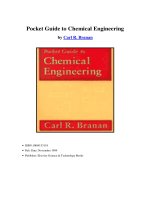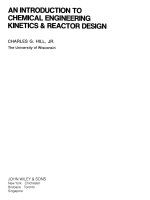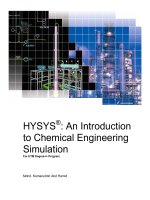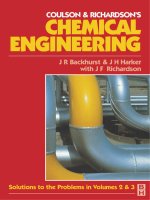pocket guide to chemical engineering, elsevier
Bạn đang xem bản rút gọn của tài liệu. Xem và tải ngay bản đầy đủ của tài liệu tại đây (4.71 MB, 230 trang )
Pocket Guide to Chemical Engineering
by Carl R. Branan
• ISBN: 0884153118
• Pub. Date: November 1999
• Publisher: Elsevier Science & Technology Books
Introduction
This pocket guide contains selected rules of thumb and
shortcut design methods meant to travel into the field as
well as the office, even when the "office" is a hotel room. It
contains updates on certain fast-moving technology and
new material not found elsewhere. Miniaturization and easy
retrieval of information are stressed. Those on the go can
produce reasonable results quickly when using this book as
a basic source.
Carl Branan
E1 Paso, Texas
1
Fluid Flow
GENERAL
Two of the most useful and basic equations are
2
U
Ah=~
2g
(1-1)
Au 2
AP (V) + ~ + AZ + E=0 (1-2)
2g
where Ah = head loss in feet of flowing fluid
u - velocity in ft/sec
g = 32.2 ft/sec 2
P = pressure in lb/ft 2
V = specific volume in ft3/lb
Z = elevation in feet
E = head loss due to friction in feet of flowing fluid
2 Pocket Guide to Chemical Engineering
In Equation 1-1 Ah is called the "velocity head." This
expression has a wide range of utility not appreciated by
many. It is used "as is" for
1. Sizing the holes in a sparger
2. Calculating leakage through a small hole
3. Sizing a restriction orifice
4. Calculating the flow with a pitot tube
With a coefficient it is used for
1. Orifice calculations
2. Relating fitting losses
3. Relief valve sizing
4. Heat exchanger tube leak calculations
For a sparger consisting of a large pipe having small
holes drilled along its length, Equation 1-1 applies directly.
This is because the hole diameter and the length of fluid
travel passing through the hole are similar dimensions. An
orifice, on the other hand, needs a coefficient in Equation 1-
1 because hole diameter is a much larger dimension than
length of travel (say ~ in. for many orifices). Orifices will
be discussed under "Metering" later in this chapter.
For compressible fluids one must be careful that when
sonic or "choking" velocity is reached, further decreases in
downstream pressure do not produce additional flow. This
occurs at an upstream to downstream absolute pressure
ratio of about 2:1. Critical flow due to sonic velocity has
practically no application to liquids. The speed of sound in
liquids is very high. See "Sonic Velocity" in this chapter.
Fluid Flow 3
Still more mileage can be obtained from Ah - u2/2g
when using it with Equation 1-2, which is the famous
Bernoulli equation. The terms are
1. The PV change
2. The kinetic energy change or "velocity head"
3. The elevation change
4. The friction loss
These contribute to the flowing head loss in a pipe. Howev-
er, there are many situations where by chance, or on pur-
pose, u2/2g head is converted to PV or vice versa.
We purposely change u2/2g to PV gradually in the fol-
lowing situations:
1. Entering phase separator drums to cut down turbu-
lence and promote separation
2. Entering vacuum condensers to cut down pressure
drop
We build up PV and convert it in a controlled manner to
u2/2g in a form of tank blender. These examples are dis-
cussed under appropriate sections.
PIPING PRESSURE DROP
A handy relationship for turbulent flow in commercial
steel pipes flowing full is:
AP F Wl.8~to.2/20,000d4.Sp
(~-3)
4 Pocket Guide to Chemical Engineering
where APF = frictional pressure loss, psi/lO0 equivalent ft
of pipe
W = flow rate, lb/hr
= viscosity, cp
9 = density, lb/ft 3
d = internal pipe diameter, in.
This relationship holds for a Reynolds number range of
2,100 to 106 . For smooth tubes (assumed for heat exchang-
er tubeside pressure drop calculations), a constant of 23,000
should be used instead of 20,000.
For most common fluids the following equation also
works quite well for ballpark checking and feasibility work:
W = 370 x/AP 9 d5
where
W = flow in lb/hr
AP = friction loss in lb/in 2 (psi) per 100 ft
9 - density in lb/ft 3
d = inside diameter of pipe in inches
This is a form of the Fanning or Darcy formula with fric-
tion factor - 0.0055. This friction factor corresponds to
approximately the following:
Commercial steel pipes
Reynolds number 10 5
Williams and Hazen C factor -
110
Fluid Flow S
For other friction factors multiply the right hand side by
I 0.0055
friction factor
The friction factor can be approximated by
Laminar flow, f - 16/Re
Commercial pipes, f - 0.054/Re ~
Smooth tubes, f - 0.046/Re ~
Extremely rough pipes, f - 0.013
where Re is the well known Reynolds number. In this case:
h L
friction factor - (Fanning)
4 (L/D) (u2/2g)
where h L - friction head loss in feet
L - length in feet
D - diameter in feet
Be careful when applying the friction factor. Sometimes it
is defined as
hE
(L/D) (u2/2g)
(Moody)
The pressure drop equations apply to liquids. They also
apply to compressible fluids for non-critical flow and AP <
10% P1,
6 Pocket Guide to Chemical Engineering
where AP - line pressure drop, psi
P l upstream pressure, psia
For compressible flow where AP > 10% P1, either break
into sections where AP < 10% P~ or use
2P,
AP=PI-P2=pI +P2
(fLd ln(Pl/P2)) UI2]
0.323 -7 + Sl
24
(1-4)
from Reference 2 that assumes isothermal flow of ideal gas.
In Equation 1-4,
P~, P2 = upstream and downstream pressures in psi
abs
S~ specific gravity of vapor relative to water
0.00150 MPI/T
d pipe diameter, in.
U l - upstream velocity, ft/sec
f friction factor (assume .005 for approximate
work)
L length of pipe, ft
AP - pressure drop in psi (rather than psi per
standard length as before)
M - mol. wt.
Table 1-1 gives the equivalent length of straight pipe for
various fittings (see pp. 10 and 11).
Fluid Flow 7
FLOW IN PARTIALLY FULL HORIZONTAL PIPES
The equations in the section "Piping Pressure Drop" are,
of course, intended for use with full pipes. Reference 12
provides a rapid way to estimate whether a horizontal pipe
carrying liquid is full. The criteria are
If Q/d 2"5 > 10.2, the pipe is running full.
If Q/d 2"5 < 10.2, Equation 1-5 is given for determining
H/D, which is needed for a partially full flow analysis:
Yl - 0.446 + 0.272Xl + 0.0397xl 2 - 0.0153Xl 3
- 0.003575xl 4 (1-5)
Once H/D is known, A (the flow area) can be found by
Y2 0.003597 + 0.3385x 2 + 1.3609x22
- 0.9075x23 (1-6)
Also the "equivalent diameter" can be found by
Y3 - -0.01130 + 3.040x 2 - 3.461
X22 +
4.108x23
- 2.638x24
(1-7)
This eliminates having to calculate the equivalent
diameter by
De - 4 (RH) - 4 (cross-sectional flow area)/wetted
perimeter (1-8)
8 Pocket Guide to Chemical Engineering
Note that for values of H/D greater than 0.5, but less than
1.0, DJD > 1.0. This results from the definition and is con-
firmed by my calculations and all of the references.
The equivalent diameter is used in place of the pipe
diameter for non-circular ducts or partially full pipes. For
example, it is used to calculate Re as a means of obtaining
f. In determining:
Re - Dup/la
D e is substituted for D; u is obtained by u - q/A.
Sometimes, however, A is expressed as [~td2]/[4(144)]
with the :t/4(144) buried into an overall coefficient. For
example, Crane 14 has a solved problem that uses the Darcy
equation form:
Q- 19.65d 2 (hLD/fL) ~
(1-9)
Here we could be confused with two diameter terms.
Remember, however, that d is really a means of expressing
area, so Crane 14 uses an "equivalent diameter of actual flow
area" that is simply:
d - [ 144 (4) A/~] ~ (1-10)
Whereas D e is substituted for D.
Fluid Flow 9
Nomenclature for Flow in Partially Full
Horizontal Pipes
A = cross-sectional flow area (for partially full
pipe),
ft 2
D = pipe diameter, ft (also represents the quantity
needing substitution by De)
d = pipe diameter, in. (also represents "equivalent
diameter of actual flow area")
De = equivalent diameter = 4RH, ft
f = friction factor in hL = fLUZ/D2g
g = acceleration of gravity 32.2 ft/sec 2
H - height of liquid in the pipe, ft
hL head loss, ft of flowing fluid
L = pipe length, ft
P = wetted perimeter, ft
Q = flow rate, gpm
q flow rate, ft3/sec
Re = Reynold's number, dimensionless
RH = hydraulic radius = A/P, ft
u = velocity, ft/sec
x l = In (Q/d 2"5)
x2, y 1 =H/D
Y2
- A/DE
Y3 - DJD
p = fluid density, lb/ft 3
Ix = fluid viscosity, lb/ft-sec
10
Pocket Guide to Chemical Engineering
Table 1 - 1
Equivalent Length of Valves and Fittings in Feet 9
,~ | 45 ~ Short Long Hard Soft
> > rad. rad.
~ -~ ~ ell ell ell T. T.
~
'~~
~ ~ "a "a "a "a "a
u
1~ 55 26 13 7 1 2 3 9 2 3
2 70 33 17 14 2 3 ~ 11 3 4
289 80 40 20 11 2 . 9 3
3 100 50 25 17 2 4
4 130 65 32 30 3 5
6 200 100 48 70 4 8
8 260 125 64 120 6 9
10 330 160 80 170 7 12
12 400 190 95 170 9 14
14 450 210 105 80 10 16
16 500 240 120 145 11 18
18 550 280 140 160 12 20
20 650 300 155 210 14 23
22 688 335 170 225 15 25
24 750 370 185 254 16 27
30 312 21 40
36 25 47
42 30 55
48 35 65
54 m _ 40 70
60 m 45 1 80
Fluid Flow | |
Enlargement Contraction
90~ I Std. red. Sudden I sid. red.
miter bends Sudden
Equiv. L in terms of small d
i.,. I,,. IN.
~ ~ II II II II II II II II II U
9 ~. -~ -~
~ r,, ~ ,~ ~ ~ ,~ ~ ~
5 3 1 4 1 3 2 1 1
7 4 1 5 1 3 3 1 1
8 5 2 6 2 4 3 2 2
10 6 2 8 2 5 4 2 2
12 8 3 10 3 6 5 3 3
18 12 4 14 4 9 7 4 4 1
25 16 5 19 5 12 9 5 5 2
31 20 7 24 7 15 12 6 6 2
28 21 20 37 24 8 28 8 18 14 7 7 2
32 24 22 42 26 9 20 16 8
38 27 24 47 30 10 ~ 24 18 9
42 30 28 53 35 11 26 20 10
46 33 32 60 38 13 30 23 11 m
52 36 34 65 42 14 m ~ 32 25 12
56 39 36 70 46 15 35 27 13
70 51 44
84 60 52
98 69 64
112 81 72
126 90 80
190 99 92
12 Pocket Guide to Chemical Engineering
TWO-PHASE FLOW
Two-phase flow is beyond the scope of this pocket
guide. One word of advice: Be careful when designing low
pressure and/or flashing condensate lines. These deserve
special care. Ruskin l~ has a quick method for condensate
line sizing.
PIPING RULES OF THUMB
Tables 1-2, 1-3, and 1-4 give typical piping rules of
thumb.
SONIC VELOCITY
To determine sonic velocity use
V s = ~KgRT (1-11)
where Vs - sonic velocity, ft/sec
K - Cp/Cv the ratio of specific heats at constant
pressure to constant volume. This ratio is 1.4
for most diatomic gases.
g - 32.2 ft/sec 2
R - 1,544/mol wt
T - absolute temperature in ~
Fluid Flow
13
Table 1-2
Sizing Steam Piping in New Plants
Maximum Allowable Flow and Pressure Drop
Laterals Mains
Pressure, psig 600 175 30 600 175 30
Density, lb/CF 0.91 0.41 0.106 0.91 0.41 0.106
AP, psi/100 ft 1.0 0.70 0.50 0.70 0.40 0.30
Nominal Pipe
Size, in.
Maximum Ib/hr x 10 -3
3 7.5 3.6 1.2 6.2 2.7 0.9
4 15 7.5 3.2 12 5.7 2.5
6 40 21 8.5 33 16 6.6
8 76 42 18 63 32 14
10 130 76 32 108 58 25
12 190 115 50 158 87 39
14 260 155 70 217 117 54
16 360 220 100 300 166 78
18 300 130 227 101
20 170 132
Note:
1. 600 psig steam is at 750~ 175 psig and 30 psig are saturated.
2. On 600 psig flow ratings, internal pipe sizes for larger nominal
diameters were taken as follows: 18/16.5 in., 14/12.8 in., 12/11.6 in.,
10/9.75 in.
3. If other actual I.D. pipe sizes are used, or if local superheat exists on
175 psig or 30 psig systems, the
allowable pressure drop
shall be the
governing design criterion.
14 Pocket Guide to Chemical Engineering
Table 1-3
Sizing Cooling Water Piping in New Plants
Maximum Allowable Flow, Velocity, and Pressure Drop
Laterals Mains
Pipe Size Flow Vel. AP Flow Vel. AP
in. gpm fl/sec ft/lO0 fl gpm fl/sec fl/lO0 ft
3 100 4.34 4.47 70 3.04 2.31
4 200 5.05 4.29 140 3.53 2.22
6 500 5.56 3.19 380 4.22 1.92
8 900 5.77 2.48 650 4.17 1.36
10 1,500 6.10 2.11 1,100 4.48 1.19
12 2,400 6.81 2.10 1,800 5.11 1.23
14 3,100 7.20 2.10 2,200 5.13 1.14
16 4,500 7.91 2.09 3,300 5.90 1.16
18 6,000 8.31 1.99 4,500 6.23 1.17
20 6,000 6.67 1.17
24 11,000 7.82 1.19
30 19,000 8.67 1.11
To determine the critical pressure ratio for gas sonic veloci-
ty across a nozzle or orifice use
critical pressure ratio = [2/(K + 1)]k/r
1)
(1-12)
If pressure drop is high enough to exceed the critical ratio,
sonic velocity will be reached. When K = 1.4, ratio = 0.53.
Fluid Flow 15
Table 1-4
Sizing Piping for Miscellaneous Fluids
Dry Gas
Wet Gas
High Pressure Steam
Low Pressure Steam
Air
Vapor Lines General
Light Volatile Liquid Near Bubble
Pt. Pump Suction
Pump Discharge, Tower Reflux
Hot Oil headers
Vacuum Vapor Lines below 50 MM
Absolute Pressure
100 ft/sec
60 ft/sec
150 ft/sec
100 ft/sec
100 ft/sec
Max. velocity 0.3 mach
0.5 psi/100 ft
0.5 ft head total
suction line
3-5 psi/100 ft
1.5 psi/100 ft
Allow max. of 5%
absolute pressure
for friction loss
CONTROL VALVE DESIGN
Notes:
1. References 4 and 5 were used extensively for this sec-
tion. The sizing procedure is generally that of Fisher
Controls Company.
2. Use manufacturers' data where available. This hand-
book will provide approximate parameters applicable
to a wide range of manufacturers.
16 Pocket Guide to Chemical Engineering
3. For any control valve design, be sure to use one of the
modem methods, such as that given here, that takes
into account such things as control valve pressure
recovery factors and gas transition to incompressible
flow at critical pressure drop.
Liquid Flow
Recall the previous discussion of converting PV to u2/2g.
Across a control valve, the fluid is accelerated to some
maximum velocity. At this point the pressure reduces to its
lowest value. If this pressure is lower than the liquid's
vapor pressure, flashing will produce bubbles or cavities of
vapor. The pressure will rise or "recover" downstream of
the lowest pressure point. If the pressure rises to above the
vapor pressure, the bubbles or cavities collapse. This causes
noise, vibration, and physical damage.
When there is a choice, design for no flashing. When
there is no choice, locate the valve to flash into a vessel if
possible. If flashing or cavitation cannot be avoided, select
hardware that can withstand these severe conditions. The
downstream line will have to be sized for two-phase flow.
It is a good idea to use a long conical adaptor from the con-
trol valve to the downstream line.
When sizing liquid control valves first use
APallow = Km(PI - rcPv)
(1-13)
where APallo w - maximum allowable differential pressure
for sizing purposes, psi
Fluid Flow 17
K m - valve recovery coefficient (see Table 1-7)
rc = critical pressure ratio (see Figures 1-1 and
1-2)
P] - body inlet pressure, psia
Pv - vapor pressure of liquid at body inlet
temperature, psia
This gives the maximum AP that is effective in producing
flow. Above this AP, no additional flow will be produced
Critical Pressure Ratios For Wafer
1.0
I. u
(~ 0.9
m
I
w 0.8
n,,
t/)
u,)
LI.I
,v 0.7
Q.
_.1
u
~ 0.6
1
U
\
0.5
0 500
1000 1500 2000 2500 3000 3500
VAPOR
PRESSURE-PSIA
Figure 1-1.
Enter on the abscissa at the water vapor pressure at the
valve inlet. Proceed vertically to intersect the curve. Move horizontally
to the left to read rc on the ordinate?
18 Pocket Guide to Chemical Engineering
Critical Pressure Ratios For Liquids Ofher Than Wafer
I
I.O
g
,~ 0.9
I1:
W
e:
0.8
2~
ffl
t~ 0.7
(1.
~0.6
9 10 .20 .30 .~0 .50 .60 .70 .80 .90 1.00
VAPOR PRESSURE PSIA
CRITICAL PRESSURE PSIA
Figure I-2. Determine the vapor pressure/critical pressure ratio by
dividing the liquid vapor pressure at the valve inlet by the critical
pressure of the liquid. Enter on the abscissa at the ratio just calculated
and proceed vertically to intersect the curve. Move horizontally to the
left and read re on the ordinate. 4
because flow will be restricted by flashing. Do not use a
number higher than APallo w in the liquid sizing formula.
Some designers use as the minimum pressure for flash
check the upstream absolute pressure minus two times con-
trol valve pressure drop.
Table 1-5 gives critical pressures for miscellaneous flu-
ids. Table 1-6 gives relative flow capacities of various
types of control valves. This is a rough guide to use in lieu
of manufacturer's data.
Fluid Flow 19
Table 1-5
Critical Pressure of Various Fluids, psia*
Ammonia 1636 Isobutane
Argon 705.6 Isobutylene
Butane 550.4 Methane
Carbon Dioxide 1071.6 Nitrogen
Carbon Monoxide 507.5 Nitrous Oxide
Chlorine 1118.7 Oxygen
Dowtherm A 465 Phosgene
Ethane 708 Propane
Ethylene 735 Propylene
Fluorine 808.5 Refrigerant 11
Helium 33.2 Refrigerant 12
Hydrogen 188.2 Refrigerant 22
Hydrogen Chloride 1198 Water
529.2
580
673.3
492.4
1047.6
736.5
823.2
617.4
670.3
635
596.9
716
3206.2
*For values not listed, consult an appropriate reference book.
The liquid sizing formula is
IG
Cv=Q AP
where Cv = liquid sizing coefficient
Q = flow rate in gpm
AP = body differential pressure, psi
G = specific gravity (water at 60~ = 1.0)
(1-14)
20
Pocket Guide to Chemical Engineering
Table !-6
Relative Flow Capacities of Control Valves s, 20
Valve Type Cd ~ CdFp t CdFt ~
Double-seat globe 12 11 11
Single-seat top-guided globe 11.5 10.8 10
Single-seat split body 12 11.3 10
Sliding gate 6 12 6-11 na
Single-seat top-entry cage 13.5 12.5 11.5
Eccentric rotating plug (Camflex) 14 13 12
60 ~ open butterfly 18 15.5 12
Single-seat Y valve (300 & 600 lb) 19 16.5 14
Saunders type (unlined) 20 17 na
Saunders type (lined) 15 13.5 na
Throttling (characterized) ball 25 20 15
Single-seat streamlined angle
(flow-to-close) 26 20 13
90 ~ open butterfly (average) 32 21.5 18
Note: This table may serve only as a rough guide because actual flow
capacities differ between manufacturer's products and individual
valve sizes. 20
*Valve flow coefficient Cv = Ca x d 2 (d = valve dia., in.)
tC,,/d 2 of valve when installed between pipe reducers (pipe dia. 2 x
valve dia.)
**CJd 2 of valve when undergoing critical (choked)flow conditions
Two liquid-control-valve-sizing rules of thumb are
1. No viscosity correction necessary if viscosity < 20
centistokes.
2. For sizing a flashing control valve, add the Cv's of the
liquid and the vapor.
Fluid Flow 21
GAS AND STEAM FLOW
The gas and steam sizing formulas are
Gas
Q (1-15)
Cg-/520plsin 34171AP ]
~/GT 'Cl ~ Oeg
Steam (under 1,000 psig)
Cs _ Qs (1 +_ 0.00065, Tsh) (1 - 16)
P1
sin Cl
deg
Steam and vapors (all vapors, including steam under any
pressure conditions)
Cg - Qs (1-17)
1.06 d~~lPl sin [ 3, 417 A~-~]
El" deg
When the bracketed quantity in the equations equals or
exceeds 90 ~ critical flow is indicated. The quantity must be
limited to 90 ~ This then becomes unity because sin 90 ~ - 1.
22
Pocket Guide to Chemical Engineering
Explanation of terms:
C1 Cg/Cv (some sizing methods
use
Cf or Y in place of
Cl)
Cg = gas sizing coefficient
Cs steam sizing coefficient
Cv - liquid sizing coefficient
dl - density of steam or vapor at inlet, lb/ft 3
G - gas specific gravity - mol wt/29
Pl - valve inlet pressure, psia
AP = pressure drop across valve, psi
Q = gas flow rate, scfh
Qs = steam or vapor flow rate, lb/hr
T - absolute temperature of gas at inlet, ~
Tsh = degrees of superheat, ~
The control valve coefficients in Table 1-8 are for full
open conditions. The control valve must be designed to oper-
ate at partial open conditions for good control. Figure 1-3
shows partial open performance for a number of trim types.
CONTROL VALVE RULES OF THUMB
1. Design tolerance. Many use the greater of the following:
Qsizing -
1.3
Qnormal
Qsizing- 1.1 Qmaximum
(text continued on page 25)
Fluid Flow
23
Table 1-7
Average Valve-Recovery Coefficients, Km and Ci *s
Type of Valve Km CO
Cage-trim globes:
Unbalanced 0.80 33
Balanced 0.70 33
Butterfly:
Fishtail 0.43 16
Conventional 0.55 24.7
Ball:
Vee-ball, modified-ball, etc. 0.40 22
Full-area ball 0.30
Conventional globe:
Single and double port (full port) 0.75 35
Single and double port (reduced port) 0.65 35
Three way 0.75
Angle:
Flow tends to open (standard body) 0.85
Flow tends to close (standard body) 0.50
Flow tends to close (venturi outlet) 0.20
Camflex:
Flow tends to close 0.72 24.9
Flow tends to open 0.46 31.1
Split body 0.80 35
*For use only if not available from manufacturer.




